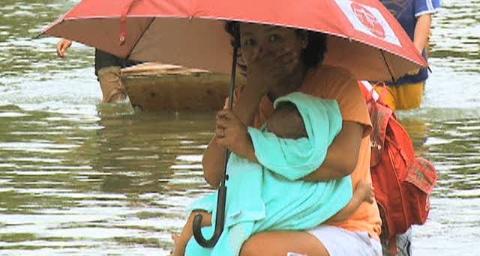
© VOA Image
In Southeast Asia, people know well the risks that extreme weather can bring, and they worry that a warmer climate will increase those risks.
When Typhoon Ketsana hit Manila this year, the crowded city's planners were stunned at the amount of rain that poured down in a short time. Houses here sit close to the ground, even though the land is lower than a lake nearby.
"The most concerned extreme events in Southeast Asia is probably storm - typhoon and tropical storm," said climate scientist Anond Snidvongs.
Dr. Anond Snidvongs, who has studied climate change for more than a decade, has analyzed storm data over the past 60 years. Storm frequency, he says, comes in cycles of 30 years. But, he warns, warmer global temperatures could bring more, and bigger, storms.
"We are going on the rise again, but that's due to normal cycles," he added. "But if you look into the Mekong delta, for example in Vietnam, it has shown the 30-year cycle, but the phase and amplitude is going up and then going up like that."
This means, he says, that the Philippines, the southern part of Vietnam and Cambodia will be hit with more storms than experienced in recent decades.
Here in Can Tho, in southern Vietnam, boats carrying goods converge on the Mekong River to trade.
Cuong is a trader from the nearby coastal province of Ben Tre. His job, he says, is vulnerable to weather changes.
"In the past, everything was fine, but in the last 10 years, there were so many storms," he said.
A storm destroyed his house in 2007, he says. And worse, storm surges have tainted the water supply with salt.
"We already have water shortage before. Now the water shortage is worse," he added.
In Southeast Asia, where millions of people are vulnerable to the effects of climate change, such as drought or unusually heavy rains, there are growing concerns for the future.
Hassan Moinuddin of the Asian Development Bank's Mekong Sub-Region Program says a warmer climate could cut almost seven percent off the region's gross domestic product by the end of this century, by reducing crops or forcing the relocation of communities.
"It not only will affect the growth and the economic development, but it will have a severe consequence especially on the disaster emergency relief funding that will be required," he explained.
As governments debate who is to shoulder greater responsibility for slowing climate change and paying for the damage, profound change, says Dr. Anond, should come from individuals.
"We need to live in harmony with climate," noted Dr. Anond.
For instance, houses should be built, taking into account their environment.
"Houses in our region used to have stilts a few meters above the ground in order to allow flood to stay there," he explained.
He hopes people will adapt their lifestyles according to the nature of their environment, and help them lessen the effects of climate change.

Reader Comments
to our Newsletter